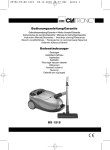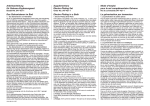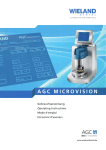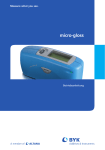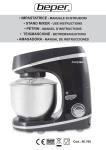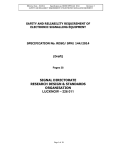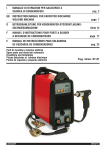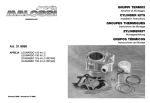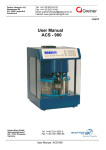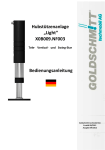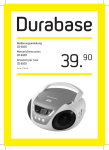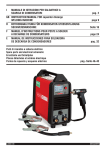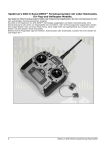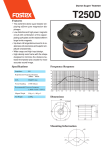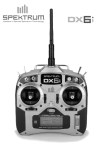Download GB Basic Electro-Plating Set D Arbeitsanleitung für Galvano
Transcript
D GB Basic Electro-Plating Set F Mode d’emploi pour le set de base Galvano Order No. 547-420-2 No comm. 547-420-2 Electro-Plating Galvaniser, galvanisation – how does it work? The following sketch shows a basic set-up to roughly explain electro-plating. A metallic object, such as a key, is placed in a glass container filled with an electrolyte (e.g. copper electrolyte) opposite a piece of copper material. Both parts are attached to wires. The electrolyte, a so-called galvanic bath, contains copper, albeit in a chemical solution that makes the metal invisible. If the copper material is connected to the positive pole of a DC source – such as a battery – and the key to the negative pole, current will flow through the bath and invisible copper ions will travel to the key and settle on it as a visible copper coating. Without exIllus. 1 plaining the physical details, this is a simple way of showing the electro-plating process. The SELVA Electro-Plating Set is based upon the same principles and the similarities can quickly be recognized. Ça marche comment ? L’esquisse suivante d’un montage expérimental doit montrer les relations à grands traits. Dans un conteneur en verre qui est rempli d’un électrolyte (p. ex. un électrolyte cuivre) on accroche d’un côté un objet métallique (p. ex. une clé) et de l’autre un morceau de plaque de cuivre. Les deux objets sont fixés avec des fils de fer. Dans l’électrolyte, le soi-disant bain électrolytique, il y a du cuivre, mais en solution chimique ce qui fait le métal invisible. Lorsque nous raccordons une source de courant continu (p. ex. une pile) avec le pôle positif à la plaque de cuivre et avec le pôle Figure 1 négatif à la clé, le courant coule à travers le bain, et les particules de cuivre invisibles marchent en direction de la clé et se déposent sur la surface en tant que couche de cuivre visible. Sans expliquer les détails physiques ici, I’expérience montre de façon très simple « le principe galvanique ». Pour les techniques GALVANO pour bricoleurs on utilise exactement le principe décrit ici. On peut vite reconnaître les relations. Arbeitsanleitung für Galvano-Grundset Bestell-Nr. 547-420-2 Galvanisieren, Galvanik – wie funktioniert das eigentlich? Die nachfolgende Skizze einer Versuchsanordnung soll die Zusammenhänge in ganz groben Zügen deutlich machen. In eine Glaswanne, die mit einem Elektro-lyten (z.B. einem Kupfer-Elektrolyten) gefüllt ist, wird auf der einen Seite ein metallischer Gegenstand (z.B. Schlüssel) und auf der anderen Seite ein Stück Kupferblech eingehängt. Beide Teile sind mit Drähten befestigt. Im Elektrolyt, dem sogenannten galvanischen Bad, befindet sich Kupfer, allerdings in chemisch gelöster Form, wodurch das Metall unsichtbar ist. Schließen wir jetzt eine Gleichstromquelle (z.B. Batterie) mit dem Pluspol an das Kupferblech und mit Bild 1 dem Minuspol an den Schlüssel an, dann fließt Strom durch das Bad, und die unsichtbaren Kupferteilchen wandern zum Schlüssel und schlagen sich auf der Oberfläche als sichtbare Kupferschicht ab. Ohne hier die physikalischen Einzelheiten zu erklären, zeigt der Versuch in einfachster Form das »galvanische Prinzip«. Bei den HEIM-GALVANOTechniken wird genau das hier beschriebene Prinzip verwendet. Die Zusammenhänge lassen sich schnell erkennen. Das Tamponverfahren 1. Das Säubern und Polieren Der zu galvanisierende Gegenstand muss völlig sauber und hochglänzend poliert sein. Mit dem beigefügten Metallputzmittel oder einem ähnlichen Putzmittel und Lappen oder Papiertaschentuch den Gegenstand so lange behandeln, bis er makellosen Hochglanz zeigt. Je besser der Hochglanz, um so schöner wird nachher die galvanische Auflage. Der galvanische Überzug gleicht keine rauhe Oberfläche oder gar Kratzer aus! Wenn nur zum Schutz galvanisiert wird, z.B. mit Nickel als Schutz gegen Rost, ist Hochglanz nicht erforderlich. 2. Das Galvanisiergerät Den richtigen Galvanisierkopf und das richtige Bild 2 Schwämmchen wählen (siehe Tabelle). Das entsprechende Schwämmchen in Wasser einweichen und wieder gut ausdrücken. Das jetzt nur noch feuchte Schwämmchen mit der einen Öse (Loch) an einem Haken des Galvanisierkopfes einhängen, vorsichtig Vergolden Elektrolyt Gold Galvanisierkopf Edelstahl (ohne Kennzeichnung) Schwämmchen gelb Versilbern Silber Edelstahl (ohne Kennzeichnung) rot Verkupfern Kupfer I Kupfer II Kupfer Kupfer blau violett Vernickeln Nickel Nickel (durch kleine, runde Eindruckpunkte nahe der Haken gekennzeichnet) grün 1004 466-347-5 DEF The Tampon Method 1. Cleaning and Polishing The object must be completely clean and highly polished. Use the metal cleaner that is included or a similar cleaning agent together with a cloth or paper towel to polish the object until it shows a high gloss without blemishes. The better the surface, the better the plating will be. The plating will not equalize a rough surface or cover scratches! If the plating is just meant for protection (e.g. nickel against rust), a high-gloss finish is not necessary. 2. The Electro-Plating Unit Choose the proper applicator tip and sponge Illus. 2 (see table below). Soak the sponge in water and squeeze it to remove excess moisture. Place the sponge over the tip and hook it on both sides (Illus. 2). Fit the applicator tip to the tube of the plating unit. Elektrolyte Applicator Tip Sponge Goldplating Gold Stainless steel (no marking) Yellow Silverplating Silver Stainless steel (no marking) Red Copperplating Copper I Copper II Copper Copper Blue Violet Nickelplating Nickel Nickel (small dimples near the hooks) Green All sponges are identical, but have different colors so that they can be identified and re-used with the same electrolytes. If different electrolytes are allowed to come in contact with each other, they may become inactive. 3. The Power Supply Use a 3V DC power supply with a diam. 2.5mm plug, approx. 250–300 mAmps. Please do not use a higher current! Le procédé par tamponnement 1. Nettoyage et polissage L’objet à galvaniser doit être absolument propre et poli brillant. Traiter l’objet avec le produit à nettoyer les métaux cijoint ou un autre produit similaire et un chiffon ou un mouchoir en papier jusqu’à ce qu’il montre une brillance parfaite. Meilleure la brillance, plus beau le revêtement galvanique. La couche galvanique n’égalise ni une surface rugueuse ni des rayures. Lorsqu’on ne galvanise que pour la protection, p. ex. avec nickel comme protection contre la rouille, la brillance n’est pas nécessaire. 2. Appareil à galvaniser Electrolyte Tête de l’appareil à galvaniser Eponge Dorer Or Acier spécial (sans marquage) jaune Argenter Argent Acier spécial (sans marquage) rouge Cuivrer Cuivre I Cuivre II Cuivre Cuivre bleue violette Nickeler Nickel Nickel (marqué par de petites impressions rondes près des crochets) verte Choisir la tête de l’appareil à galvaniser et l’éponge correctes (voir table). Faire tremper l’éponge appropriée Figure 2 dans l’eau et presser la bien. Puis fixer l’éponge humide avec le trou sur un crochet de la tête de l’appareil à galvaniser, tirer l’éponge avec précaution au-dessus de la über denselben ziehen und mit dem anderen Loch am zweiten Haken fixieren. Den Galvanisierkopf dann in das Rohr des Galvanisiergeräts stecken. Die verschieden gefärbten Schwämmchen sind von gleicher Beschaffenheit, jedoch soll es die Färbung dem Anwender ermöglichen, für einen bestimmten Elektrolyten das gleiche Schwämmchen immer wieder zu verwenden. Der Grund: Verunreinigungen oder Vermischungen untereinander können Elektrolyte unwirksam werden lassen. Guide the plug into the plating unit so that it engages easily. The tip of the plug must be connect to the positive pole. Illus. 3 For a first try, batteries can be used (2 fresh 1.5V C alkaline batteries), positive poles up. For serious plating, always use a power supply. When using the latter, do not leave batteries in the plating unit. 3. Die Stromversorgung Durch ein Netzgerät mit einem 2,5mm-Stecker. 3 Volt Gleichspannung, ca. 250–300 mA Stromstärke. Bitte keine höhere Spannung verwenden. Den Stecker nur soweit in den Galvanisierstab + Ø 2,5 mm einführen, dass er leicht einrastet! An der Spitze des Steckers muss Plus sein. Bild 3 Für einen ersten Versuch können auch Batterien verwendet werden (2 Babyzellen mit je 1,5 Volt), aber bitte nur frische Alkaline-Batterien verwenden! Pluspole nach oben. Wer ernsthaft galvanisieren möchte, verwendet jedoch ein Netzteil. Bitte keine Batterien im Gerät belassen, wenn mit einem Netzgerät gearbeitet wird. 4. Das Galvanisieren Den zu galvanisierenden Gegenstand an der Krokodilklemme des Galvanisierstab-Kabels anklemmen. Ein wenig Elektrolyt in einen kleinen Kunststoff- oder Glasbehälter gießen. Zunächst nur ein wenig, später je nach Bedarf mehr, aber immer nur soviel, wie gebraucht wird. Es empfiehlt sich nämlich nicht, eine kleine Restmenge Elektrolyt, die oft verunreinigt und mehr oder weniger verbraucht ist, am Ende zurückzufüllen. Mit dem Elektrolyt kann so lange galvanisiert werden, bis die Metallabscheidung aufhört. Der Elektrolyt ist dann erschöpft und muss ersetzt werden. Der mit dem Schwämmchen überzogene Galvanisierkopf wird in den Elektrolyten getaucht, dann wird der Gegenstand über dem ElektrolytBehälter mit etwas Druck und langsamen, ruhigen Bewegungen bestrichen. Wichtiger Hinweis: Den Elektrolyten nicht etwa wie Farbe auf den Gegenstand auftragen. Beim Galvanisieren wird nichts aufgetragen, sondern durch die Wirkung des Stromes werden die Metall-Ionen auf der Oberfläche des Gegenstandes abgeschieden. Dieser Vorgang braucht seine Zeit und es muss eine gute Berührung zwischen Schwämmchen und Gegenstand vorhanden sein. Den Galvanisierkopf deshalb nicht verkanten. Wer den Elektrolyten »wie Farbe aufträgt«, unterbricht dauernd den Stromkreis, der Strom kann immer nur kurzfristig fließen, und das Ergebnis wird entsprechend schlecht sein. Also: Das Schwämmchen ruhig auf dem Gegenstand belassen und mit leichtem Druck hin- und herreiben. Das Schwämmchen zwischendurch immer wieder tauchen und dadurch tropfnass halten. 5. Die Nachbehandlung Sobald die galvanische Schicht die gewünschte Stärke erreicht hat, den Gegenstand unter fließendem Wasser spülen und abtrocknen. Danach mit Poliertuch, Papiertaschentuch oder weichem Lappen kräftig polieren, bis alle matten Stellen verschwunden sind und Hochglanz entsteht. Gegebenenfalls gesamten Vorgang wiederholen. Das Metallputzmittel ist nicht für das Endpolieren vorgesehen.Will sich jedoch der Hochglanz am Schluss nicht richtig einstellen, kann es wie folgt angewandt werden: Das Metallputzmittel nur dünn mit dem Finger auf den Gegenstand auftragen. Danach vollständig antrocknen lassen, bis ein weiß-grauer Belag sichtbar wird, erst dann vorsichtig polieren. Der erste Versuch Nehmen Sie eine Zweipfennigmünze und reinigen Sie diese gründlichst mit Lappen, Küchenpapier und Metallputzmittel, dann gut abspülen. Die Münze muss am Schluss wie neu aussehen. Jetzt nehmen Sie einen Streifen Küchen-Alufolie, an den Sie die Krokodilklemme des 4. Electro-Plating Hook the object to be plated to the crocodile clamp of the plating unit. Pour a small amount of electrolyte into a plastic or glass dish. Start with little liquid and add as required since used electrolytes should not be saved. Electrolytes can be used until metal is no longer deposited: The electrolyte is then spent and has to be replaced. The applicator tip with sponge is dipped into the electrolyte, then the object is held over the electrolyte dish and treated with slow and steady motions of the applicator tip. Please note: Electrolytes are not applied to an object as paint would be. Electro-plating does not add a layer, the applied current causes metal ions to be transferred to the object’s surface. This process takes time and a good contact between sponge and object is required. Do not set the sponge on edge. Applying the electrolyte »like paint« interrupts the flow of current and the result will be poor. Ergo: Rest the sponge on the object and move it back and forth. Dip the sponge every now and then to keep it soaking wet. 1004 466-347-5 DEF + Ø 2,5 mm 5. Finishing As soon as the plating has reached the desired strength, wash the object under running water and dry it off. Polish it with a polishing cloth, a paper napkin or a soft rag until all mat areas disappear and a high polish is achieved. If necessary, repeat the polishing action. The metal polish is not meant for final finishing, however, if a good polish cannot be obtained, it can be used as follows: Apply a thin coat of metal polish with a finger. Let it dry completely (grayish appearance), then polish carefully. The First Try Take a copper coin and thoroughly clean it with a cloth, paper towel and metal polish. Rinse it well. After polishing, the coin should look as new. Take a strip of aluminum foil and Illus. 4 hook the crocodile clamp of the plating unit to it (Illus. 4). Place the coin onto the strip for a good contact. Pour a few milliliters of silver electrolyte into a small dish. Soak the sponge of the applicator tip well, then rub the coin slowly and steadily without interruption. The coin will almost immediately change to a bluishblack color. After approx. 1 minute, rinse the coin in water and polish it with a cloth. A blank silver finish will appear from under the dark coating. Pour the almost unused silver electrolyte back into its bottle, then plate the other side of the coin with gold electrolyte. This plating, too, will need to be polished. In between the two plating processes, do not forget to change the sponge and rinse out the dish! After finishing, rinse all parts with water. Corroded applicator tips need to be cleaned up. Before doing any further plating work, please read these instructions to the end. Facts to Know • In normal use, electrolytes do no harm. They should, however, be kept out of the reach of children and away from foods. Eyes should be protected since electrolytes can be caustic (immediately rinse with clear water). tête de l’appareil à galvaniser et fixer l’autre trou de l’éponge au deuxième crochet. Puis mettre la tête de l’appareil à galvaniser dans le tube de l’appareil à galvaniser. Les éponges de couleurs différentes sont d’une qualité égale, mais la coloration doit permettre à l’utilisateur d’utiliser toujours la même éponge pour un certain électrolyte. La raison en est: des contaminations ou des mélanges peuvent rendre les électrolytes inefficaces. 3. Alimentation en courant Par une unité d’alimentation de courant continu avec un connecteur de 2,5 mm, tension continue de 3 Volt, intensité de courant d’env. 250 à 300 mA. + Ø 2,5 mm N’utilisez pas une tension plus forte. N’introduisez le connecteur que si profondément Figure 3 dans le tube de l’appareil de galvanisation qu’il s’encliquette facilement ! Le pôle positif doit se trouver à la tête du connecteur. Pour une première expérience on peut égale-ment utiliser des piles (piles rondes avec 1,5 Volt chacune), mais seulement des piles alcalines fraîches. Pôles positifs en haut. Celui qui veut galvaniser sérieusement, utilise pourtant une unité d’alimentation. Ne laissez pas des piles dans l’appareil, lorsque vous travaillez avec une unité d’alimentation. 4. La galvanisation Coincer l’objet à galvaniser à la pince crocodile du câble de l’appareil de galvanisation. Verser un peu d’électrolyte dans un petit conteneur en matière plastique ou verre. Proportionner la quantité selon vos besoins. En effet il ne convient pas de reverser dans le flacon une petite quantité résiduelle de l’électrolyte qui est souvent contaminée ou plus ou moins consumée. On peut galvaniser avec l’électrolyte aussi longtemps que le métal ne se dépose plus. L’électrolyte est alors épuisé et doit être remplacé. Immerger la tête de l’appareil de galvanisation recouverte de l’éponge dans l’électrolyte, puis enduire l’objet au-dessus du conteneur de l’électrolyte avec une certaine pression, et de mouvements lents et calmes. Remarque importante: Ne pas appliquer l’électrolyte sur l’objet comme une peinture. Lors de la galvanisation on n’applique rien, mais par l’effet du courant les ions de métal sont déposés sur la surface de l’objet. Cette procédure dure un certain temps, et le contact entre l’éponge et l’objet doit être bon. C’est pourquoi il ne faut pas coincer la tête de l’appareil de galvanisation. Celui qui « applique l’électrolyte comme une peinture », interrompt toujours le circuit de courant; le courant ne peut couler que momentanément, et en conséquence le résultat sera mauvais. Donc: Laisser l’éponge sur l’objet et frotter la avec une légère pression. Immerger l’éponge de temps en temps pour qu’elle soit toujours trempée. 5. Traitement ultérieur Aussitôt que la couche électrolytique a obtenu l’épaisseur désirée, laver l’objet sous l’eau courante et essuyer le. Puis polir fortement avec un chiffon à polir, un mouchoir en papier ou un chiffon mou, jusqu’à ce que tous les taches ternes aient disparu et la surface brille. En cas de besoin répéter toute la procédure. Le produit à nettoyer les métaux n’est pas prévu pour le polissage final. Lorsqu’à la fin, la surface ne brille pas parfaitement, on peut procéder comme suit: N’appliquer qu’une couche mince du produit à nettoyer les métaux avec le doigt sur l’objet. Puis laisser sécher complètement jusqu’à ce qu’une couche blanche-grise devienne visible, puis polir avec précaution. La première expérience Prenez une pièce de monnaie de dix centimes et nettoyez-la profondément avec un chiffon, un essui-tout et un produit à nettoyer les métaux, puis lavez-la très bien. A la fin la pièce de monnaie doit paraître nouvelle. Maintenant prendre Galvanisierstabes anklemmen Bild 4 (siehe Bild 4). Die Münze auf den Streifen legen, und schon haben Sie einen guten Kontakt. In einen kleinen Kunststoffoder Glas-behälter ein paar ml Silber-Elektrolyt gießen. Das Schwämmchen am Galvanisierkopf gut tränken, dann damit die Münze langsam und ruhig, ohne abzusetzen, bestreichen. Sie sehen, dass die Münze sofort die Farbe verändert und blau-schwarz wird. Nach ca. 1 min, die Münze mit Wasser spülen und danach mit einem Lappen polieren. Unter der dunklen Schicht kommt die blanke Silberauflage zutage. Den noch kaum gebrauchten Silber-Elektrolyten wieder zurückschütten, dann den Vorgang mit Gold-Elektrolyt auf der anderen Seite der Münze wiederholen. Auch die Goldauflage verlangt nach dem Galvanisieren ein gründliches Polieren. Zwischen den beiden Galvanisiervorgängen, den Schwämmchenwechsel und das Spülen der Wanne nicht vergessen! Am Ende alle Teile gut mit Wasser reinigen. Wenn die Galvanisierköpfe nach einiger Zeit korrodiert sind, diese wieder blank machen. Vor weiteren Versuchen empfehlen wir dringend, die Gebrauchsanleitung zu Ende zu lesen! Sie bewahren sich dadurch vor Misserfolgen. Einige Dinge, die man wissen muss: • Die Elektrolyte sind bei normalem Gebrauch ungefährlich. Sie sollten jedoch von Kindern (TÜV-Empfehlung: Für Jugendliche ab 12 Jahre geeignet) und Lebensmitteln ferngehalten werden. Auch nicht in die Augen bringen, da sie dort zum Teil ätzend wirken (ggfs. sofort mit Wasser spülen und den Arzt aufsuchen). • Sollte ein Kleinkind aus Versehen einmal von den Elektrolyten etwas verschlucken, dann rufen Sie bitte folgende Telefon-Nr. an: 089/41402211. Sie erhalten von dort fachärztlichen Rat. • Die Elektrolyte niemals mischen! Stets auf größte Sauberkeit achten. Vorbereitungsarbeiten, z.B. das Reinigen des Metalls, immer sehr sorgfältig ausführen. Wenn der galvanische Überzug nicht zur Zufriedenheit ausfällt, liegt es oft daran, dass vor dem Galvanisieren nicht sorgfältig gearbeitet wurde. • Beim Galvanisieren nicht zu früh aufhören. Lieber etwas länger galvanisieren, damit die Schicht eine gut deckende Dicke bekommt. Dies ist insbesondere beim Rostschutz durch eine Nickel- oder Kupferauflage wichtig (Elektrolyte: siehe Zusatz-Angebot von Verbrauchsmaterial). Wer einen besonders guten Rostschutz wünscht, verkupfert zuerst und galvanisiert danach Nickel in nicht zu dünner Schicht auf. Eine Zwischenspülung des Gegenstandes während des Galvanisiervorganges kann unter Umständen für den Niederschlag förderlich sein. • Den Gegenstand beim Galvanisieren immer nur mit dem nassen Schwämmchen berühren. Eine direkte Berührung mit dem metallenen Galvanisierkopf vermeiden, denn dadurch würde sehr viel Strom verbraucht, was bei Verwendung von Batterien natürlich ungünstig ist. • Darauf achten, dass die Krokodilklemme (-) nicht das Aufsteckrohr am Galvanisiergerät oder den Galvanisierkopf (+) berührt. Der Stromkreis wäre dann geschlossen und die Batterien schnell leer bzw., das Netzgerät überlastet. Auch beim Einpacken des Gerätes diesen Hinweis beachten, wenn Batterien im Gerät sind. • Beginnt der Galvanisiervorgang bei Silber und Kupfer nicht in Sekunden, ist zunächst der Stromfluss zu prüfen. Am einfachsten geht das, wenn man ein Taschenlampenbirnchen mit dem Gewinde an die Krokodilklemme hält und mit dem Mittelpol des Birnchens den 1004 466-347-5 DEF • If a small child accidentally swallows some electrolyte, please contact a physician for advice. • Never mix electrolytes! Always observe cleanliness. Preparatory work, such as cleaning the metal, should be done very carefully. If the plating results are not satisfactory, it may be due to insufficient preparation. • Do not stop the plating process too soon. It is better to plate longer to achieve better coverage. This is particularly important when nickelor copper-plating for rust protection. An excellent rust protection can be achieved by first copper- and then nickel-plating the object. A rinsing during the process can be of advantage. • During plating, touch the object with the wet sponge tip only. Avoid direct contact with the metal applicator tip since this would cause very high energy consumption. • Please make sure that the crocodile clamp (-) does not touch the tube of the applicator unit or the applicator tip (+). This short-circuits the batteries causing them to discharge or the power supply could be overloaded. This is particularly important when packing the unit away with batteries installed. • If the plating process with silver or copper Illus. 5 does not begin within seconds, first check the flow of current. That can be done by holding the thread of a flashlight bulb to the crocodile clamp while holding the bulb’s center contact against the applicator tip. The bulb should now light up (Illus. 5). • If you are not entirely sure if the applicator tip is connected to »+«, you can do the following experiment: Take half of a potato. Stick two copper Illus. 6 wires into the cut surface with a gap of approx. 0.5–1 mm between the wires. Connect the wires to the crocodile clamp and the applicator tip. After approx. 2 to 5 minutes, a bluish green ring will form around the positive pole (Illus. 6). • Some metal objects are protected by invisible coats of lacquer. These have to be completely removed with solvents. Anodized objects cannot be plated at all. • If unused electrolytes show sediments of crystals or flakes (caused by cold storage conditions), these will disappear after heating the electrolyte to 25 to 40 °C and shaking it. • If, during plating, the sponges discolor, e.g., dark blue during goldplating, this is a normal process. The discoloration can be partially washed out and the sponges re-used. Electro-Plating Characteristics • Gold electrolyte contains pure 24-carat gold. The concentration is less than in, e.g., copper electrolytes – making the plating process slower. • If Copper II electrolyte is used with the tampon process, it needs to be diluted with water (1:1). • Tin- and zinc-plated objects (screws are often zinc-plated) cannot be plated directly with Copper II. The copper transfer will be poor and there might be black discoloration. In such cases, plate with Copper I electrolyte. • When plating with silver, a bluish discoloration may occur but will disappear during polishing. • Before copper- or silver-plating stainless steel or chrome, a coat of nickel has to be applied first. A base nickel coat can also be advantageous before gold-plating. It is best to perform a test. If batteries are used, a nickel base coat is mandatory. When nickel-plating, apply the une bande de papier aluminium Figure 4 à laquelle vous coincez la pince crocodile de l’appareil de galvanisation (voir figure 4). Mettre la pièce de monnaie sur la bande, et vous avez un bon contact. Verser quelques ml d’électrolyte argent dans un petit conteneur en matière plastique ou en verre. Bien imbiber l’éponge à la tête de l’appareil de galvanisation, puis enduire la pièce de monnaie lentement et calmement sans arrêt. Vous verrez que la pièce de monnaie change la couleur tout de suite et devient bleue-noire. Après environ 1 min. Iaver la pièce de monnaie avec de l’eau et puis polir avec un chiffon. Au-dessous de la couche sombre on voit le revêtement argenté brillant. Reverser l’électrolyte argent à peine utilisé dans le flacon, puis répéter la procédure avec l’électrolyte or sur l’autre côté de la pièce de monnaie. Le revêtement or demande également un polissage rigoureux après la galvanisation. Entre les deux procédures de galvanisation, ne pas oublier de remplacer l’éponge et de laver le conteneur ! A la fin nettoyer toutes les pièces rigoureusement avec de l’eau. Lorsque les têtes de l’appareil de galvanisation sont corrodées après un certain temps, il faut les polir de nouveau. Avant de faire d’autres expériences nous recommandons avec insistance de lire le mode d’emploi jusqu’à la fin ! Vous vous protégez contre des échecs. Quelques choses qu’il faut savoir: • Les électrolytes ne sont pas dangereux en cas d’une utilisation normale. Cependant il faut les éloigner des enfants (recommandation du TÜV = contrôle technique: appropriés pour des jeunes à partir de 12 ans) et des aliments. Ne pas mettre aux yeux, comme ils ont un effet caustique (en cas de besoin rincer tout de suite avec de l’eau). • Si un petit enfant avale par mégarde un peu d’électrolyte, veuillez téléphoner le numéro du centre anti-poison respectif. Vous y recevrez un conseil spécialiste. • Ne jamais mélanger les électrolytes ! Veiller toujours à la pureté maximum. Effectuer les travaux préparatoires, tels que le nettoyage du métal, toujours avec beaucoup de précaution. Lorsque le revêtement galvanique n’est pas satisfaisant, la raison en est souvent que l’on n’a pas travaillé diligemment avant la galvanisation. • Ne pas cesser de galvaniser trop bientôt. Galvaniser plutôt plus longtemps afin que le revêtement reçoive une épaisseur bien couvrante. C’est trés important pour la protection contre la corrosion par un revêtement nickel ou cuivre (électrolytes: voir offre complémentaire de matériel d’usage). Celui qui désire une protection contre la corrosion particulièrement bonne, cuivre d’abord et galvanise après une couche pas trop mince de nickel. Il peut être utile de laver l’objet pendant la procédure de galvanisation. • Ne toucher l’objet lors de la galvanisation qu’avec l’éponge mouillée. Eviter un contact direct avec la tête de l’appareil de galvanisation métallique afin d’éviter une grande consommation de courant ce qui est naturellement très défavorable si l’on utilise des piles. • Veiller à ce que la pince crocodile (-) ne touche pas le tube de l’appareil de galvanisation ou la tête de l’appareil de galvanisation (+). Le circuit de courant serait fermé, les piles seraient vides très vite et l’unité d’alimentation surchargée. Respecter ce fait également lors de l’emballage de l’appareil, s’il y a des piles dans l’appareil. • Si la procédure de galvanisation pour l’argent et le cuivre ne com- Galvanisierkopf berührt. Das Birnchen muss dann aufleuchten. • Wenn Sie nicht ganz sicher sind, ob der Galvanisierkopf auf »Plus« geschaltet ist, können Sie folgendes Experiment machen: Sie nehmen eine halbe Kartoffel und stecken 2 Kupferdrähte in einem Abstand von ca. 0,5 bis 1 cm in die Schnittfläche. Die Drähte verbinden Sie mit der schwarzen Krokodilklemme und dem Galvanisierkopf. Nach ca. 2–5 min bildet sich um den Bild 6 Pluspol ein bläulich-grüner Ring. • Manche Metallgegenstände sind mit unsichtbaren Lacken überzogen. Diese Schutzlacke müssen vor dem Galvanisieren durch ein Lösungsmittel, z.B. Verdünner o.ä., entfernt werden. Eloxierte Gegenstände lassen sich überhaupt nicht galvanisieren. • Zeigen sich in den Fläschchen mit unverbrauchtem Elektrolyt einmal Kristalle oder Flocken (entstanden durch zu kaltes Lagern), so verschwinden diese durch leichtes Erwärmen auf 25–40° C und Schütteln. • Wenn sich die Schwämmchen beim Galvanisieren verfärben (z.B. dunkelblau beim Vergolden), so ist dies normal. Zum Teil lässt sich die Verfärbung wieder auswaschen. Bild 5 Einige Besonderheiten beim Galvanisieren • Der Gold-Elektrolyt enthält echtes, 24karätiges – also reines – Gold. Die Konzentration muss zwangsläufig geringer sein als beispielsweise beim Kupfer-Elektrolyten. Der Niederschlag erfolgt deshalb beim Galvanisieren auch etwas langsamer. • Wird der Kupfer-II-Elektrolyt (Verbrauchsmaterial/Zusatzangebot) beim Tamponverfahren verwendet, ist er 1:1 mit Wasser zu verdünnen. • Verzinnte Metalle (z.B. Weißblech) und verzinkte Gegenstände (Schrauben sind oft verzinkt) können nicht direkt mit Kupfer-II galvanisiert werden, weil dann neben einer wenig guten Kupferabscheidung teilweise Schwarzfärbung eintritt. In solchen Fällen mit Kupfer-I (Verbrauchsmaterial/ Zusatzangebot) galvanisieren. • Beim Galvanisieren mit Silber tritt meist zunächst eine bläuliche Färbung ein, die aber beim Polieren verschwindet. • Will man Edelstahl (z.B. Nirosta) oder Chrom verkupfern oder versilbern, muss vorher vernickelt werden. Auch beim Vergolden empfiehlt sich oft eine Vorvernickelung. Am besten zunächst eine Probe machen. Bei der Verwendung von Batterien muss auf jeden Fall vorvernickelt werden. Beim Galvanisieren mit Nickelelektrolyt (Verbrauchsmaterial/ Zusatzangebot), mit dem Galvanisierkopf kreisende Bewegungen ausführen, da sonst in der Abscheidung Absätze auftreten können. Kopf mit dem Schwämmchen immer gut nass halten. Wer verchromte Teile galvanisieren möchte, sollte ein Netzgerät verwenden, da die nicht konstante Spannung bei Batteriebetrieb eventuell zu unbefriedigenden Ergebnissen führen kann. Die Nickelschicht auf Edelstahl oder Chrom (gelblich-silbern) braucht nicht besonders dick zu sein, da sie nur einen Haftgrund darstellt. Sie muss allerdings den Untergrund abdecken. • Messing, Kupfer, Nickel und Eisen lassen sich unmittelbar galvanisieren. Auf Eisen als erste Schicht Kupfer-I-Elektrolyt (Verbrauchsmaterial/Zusatzangebot) aufbringen. • Soll Zinn oder Blei vergoldet oder versilbert werden, empfiehlt sich folgender Weg: Nach den üblichen Vorbereitungsarbeiten zunächst mit 1004 466-347-5 DEF electrolyte with circular motions to avoid edges in the plated surface. Keep the applicator sponge wet at all times. To electro-plate chrome parts, a power supply should be used since the unstable current from batteries can cause unsatisfactory results. The nickel plating on stainless steel or chrome does not have to be particularly heavy since it is only used as a base. It does, however, have to cover the entire surface. • Brass, copper, nickel and iron can be plated directly. On iron, use Copper I first. • To gold- or silver-plate tin or lead, proceed as follows: After preparing the object, first plate with Copper I (not too thin), then apply a heavy coat of nickel and polish. Now, other applications, such as gold, can follow. If no base coat is applied, the gold-plating can disappear in the relatively soft base metal. This is particularly true if the surface is relatively rough and does not have a good polish. The disappearance can even happen at a later time making it very important to carefully apply the two base coats. • Aluminum, too, can be electro-plated. First, thoroughly clean the object with a scouring powder (e.g. Ajax) and a damp cloth. The scouring powder has to remove the top layer (i.e. the oxidation) from the aluminum surface. Rinse and dry, then clean with metal polish and rinse again. Now apply a base coat of Copper II. With aluminum, the plating process will be slower than usual. Partial Electro-Plating If parts of an object are masked, these parts will not be plated. Highly unusal effects can be created by having different metallic finishes right next to each other. The masking can be done with lacquer (e.g. nailpolish) that can afterwards be removed with nailpolish remover or solvent. Example: Using diluted nailpolish, draw initials onto a copper bracelet. Silver-plate the bracelet, then remove the nailpolish. The initials now appear copper-colored on a silver-plated background. There are, of course, many more interesting possibilties to try! Further plating projects can be realized with the SELVA ElectroPlating Supplementary Set No. 547-421-1 (immersion plating). mence pas en secondes, il faut d’abord Figure. 5 contrôler le circuit de courant. La méthode la plus simple est de tenir le filetage d’une ampoule électrique d’une lampe torche à la pince crocodile et de toucher la tête de l’appareil de galvanisation avec le pôle central de l’ampoule. L’ampoule doit alors s’allumer. • Si vous n’êtes pas tout à fait sûrs que la tête de l’appareil de galvanisation est sur « positif », vous pouvez faire l’expérience suivante: vous prenez une demie pomme de terre et enfoncez deux fils en cuivre à une distance de 0,5 à 1 cm environ dans la surface de coupe. Vous Figure 6 raccordez les fils avec la pince crocodile noire et la tête de l’appareil de galvanisation. Après 2 à 5 minutes environ un anneau bleu-vert se forme autour du pôle positif. • Certains objets métalliques sont recouverts de laques invisibles. Il faut enlever ces laques de protection avant la galvanisation par un solvant, p. ex. un diluant ou quelque chose de semblable. Des objets oxydés électrolytiquement ne peuvent pas du tout être galvanisés. • Si des cristaux ou flocons (résultant par un stockage trop froid) se montrent dans les flacons avec un électrolyte non consommé, ceux-ci disparaissent en les chauffant à 25 à 40° C et en les secouant. • Il est normal que les éponges changent de couleur lors de la galvanisation (p. ex. bleu foncé lors du dorage). En partie la coloration peut être enlevée par lavage. Quelques particularités lors de la galvanisation • L’électrolyte or contient or pur de 24 carats. La concentration doit être inévitablement plus faible qu’avec l’électrolyte cuivre par exemple. Le dépôt est donc en peu plus lent lors de la galvanisation. • Si l’on utilise l’électrolyte cuivre II (matériel d’usage / offre complémentaire) avec le procédé par tamponnement, il faut le diluer 1:1 avec de l’eau. • Des métaux étamés (p. ex. fer-blanc) et des objets zingués (les vis sont souvent zinguées) ne peuvent pas être galvanisés directement avec du cuivre II, parce qu’en dehors d’un dépôt moins bon de cuivre, une coloration partielle noire se montre. Dans ces cas galvaniser avec cuivre I (matériel d’usage / offre complémentaire). • Lors de la galvanisation avec argent une coloration bleuâtre apparaît d’abord qui disparaît pourtant lors du polissage. • Si l’on veut cuivrer ou argenter de l’acier spécial (p. ex. Nirosta) ou du chrome, il faut les nickeler auparavant. Le même s’applique au dorage. De toute façon faire un essai d’abord. Si l’on utilise des piles, il faut nickeler en tout cas. Lors de la galvanisation avec l’électrolyte nickel (matériel d’usage / offre complémentaire) faire des rotations avec la tête de l’appareil de galvanisation afin d’éviter des discontinuités dans le dépôt. Tenir la tête toujours trempée avec l’éponge. Celui qui veut galvaniser des pièces chromées devrait utiliser une unité d’alimentation en courant, comme la tension non constante lors de l’opération en batterie peut mener aux résultats non satisfaisants. Le revêtement de nickel sur l’acier spécial ou chrome (jaune-argenté) ne doit pas être très épais, comme il n’est qu’une couche de fond. Il doit pourtant recouvrir le fond. • Le laiton, le cuivre, le nickel et le fer peuvent être galvanisés directement. Sur le fer appliquer comme première couche l’électrolyte cuivre I Kupfer-I galvanisieren (nicht zu dünn), dann polieren. Danach eine gut deckende Nickelschicht aufgalvanisieren und wieder polieren. Jetzt können andere Schichten, z.B. Gold, folgen. Unterlässt man die Vorgalvanisierung, kann es vorkommen, dass die Goldauflage teilweise im verhältnismäßig weichen Grundmetall verschwindet. Dies trifft besonders dann zu, wenn die Oberfläche keinen guten Hochglanz zeigt, d.h., wenn sie verhältnismäßig rauh ist. Das Verschwinden kann auch noch nach einiger Zeit passieren, weshalb es sich lohnt, die beiden Vorschichten sorgfältig und sauber aufzutragen. • Auch Aluminium kann galvanisiert werden. Den Gegenstand zuerst mit Scheuerpulver (z.B. VIM oder ATA) und feuchtem Lappen gründlich blankputzen. Das Scheuerpulver muss dabei wie Feinst-schmirgel die oberste Haut (d.h. die Oxidschicht) des Aluminiums entfernen. Deshalb soll dabei ziemlich trocken gearbeitet werden. Danach spülen, abtrocknen und mit Metallputzmittel nochmals gut reinigen und wiederum spülen. Danach die erste Auflage mit Kupfer-II galvanisieren. Die Abscheidung vollzieht sich in diesem Fall etwas langsamer als sonst. Teilweises Galvanisieren durch Abdecken Deckt man einen Teil des Gegenstandes ab, verhindert also an dieser Stelle die Galvanisierung, so kann man sehr reizvolle Effekte erzielen, denn man erzielt schließlich zwei oder mehr unterschiedliche Metalloberflächen nebeneinander. Das Abdecken kann durch Lack – z.B. Fingernagellack – erfolgen, der anschließend mit Nagellackentferner oder Verdünnung wieder beseitigt wird. Ein Beispiel: Man schreibt Namensanfangsbuchstaben mit verdünntem Nagellack auf ein kupfernes Armband, welches versilbert werden soll. Nach dem Versilbern wird der Lack entfernt, die Buchstaben stehen dann kupferfarben im silbernen Umfeld. Es gibt natürlich noch viele andere Möglichkeiten für diese Technik. Weitere Anwendungen eröffnet das SELVA Galvano-Ergänzungs-Set Nr. 547-421-1 (Galvanisieren im Tauchbad). 1004 466-347-5 DEF (matériel d’usage / offre complémentaire). • Si l’on veut dorer ou argenter l’étain ou plomb, la procédure suivante est recommandée: après les travaux préparatoires habituels galvaniser d’abord avec cuivre I (pas trop mince), puis polir. Puis galvaniser une couche bien couvrante de nickel et polir de nouveau. Maintenant les autres couches, p. ex. or, suivent. Si l’on omet la prégalvanisation, il peut arriver que le revêtement d’or disparaît en partie dans le métal de base relativement mou. C’est le cas en particulier lorsque la surface ne montre pas une bonne brillance, c’est-à-dire lorsqu’elle est relativement rugueuse. Le revêtement d’or peut disparaître encore après quelque temps. C’est pourquoi ça vaut la peine d’appliquer les deux premières couches diligemment et proprement. • L’aluminium peut aussi être galvanisé. Nettoyer l’objet avec un produit à récurer (p. ex. VIM ou ATA) et un chiffon humide. Le produit à récurer doit enlever la peau supérieure (c’est-à-dire la couche oxyde) de l’aluminium comme un papier d’émeri très fin. C’est pourquoi il faut travailler relativement sèchement. Puis laver, essuyer et nettoyer encore une fois avec un produit à nettoyer le métal et laver de nouveau. Puis galvaniser la première couche avec cuivre II. Le cuivre se dépose dans ce cas un peu plus lentement. Galvanisation partielle par couverture Si l’on couvre une partie de l’objet, c’est-à-dire si l’on empêche donc la galvanisation à cet endroit, on peut réaliser des effets très alléchants, car on obtient deux ou plus surfaces de métal différentes l’une à côté de l’autre. On peut couvrir l’objet par une laque – p. ex. vernis à ongles – qui est éliminée après avec un solvant ou un diluant. Un exemple: On écrit des lettres initiales d’un nom avec du vernis à ongles dilué sur un bracelet cuivré qui doit être argenté. Après l’argentage la laque est enlevée, les lettres se trouvent en cuivre dans un environnement argenté. Il y a naturellement encore beaucoup d’autres possibilités pour cette technique. Autres applications sont ouvertes par le Set Complémentaire Galvano de SELVA no. 547421-1 (galvanisation par immersion).





